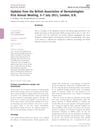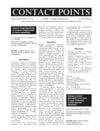Sodium Metabisulfite: Effects on Ionic Currents and Excitotoxicity
November 2017
in “
Neurotoxicity research/Neurotoxicity resarch
”
TLDR Sodium metabisulfite increases sodium channel activity, leading to higher cell excitability and potential damage.
The study investigated the effects of sodium metabisulfite (SMB) on ionic currents and excitotoxicity in HL-1 cardiomyocytes and NSC-34 neurons. SMB (30 μM) stimulated voltage-gated Na+ currents, slowed current inactivation and deactivation, and shifted the current-voltage relationship to more negative potentials. SMB-induced increases in Na+ currents were reduced by ranolazine or eugenol. Additionally, SMB inhibited the tail component of the rapidly activating delayed-rectifier K+ current dose-dependently. In NSC-34 neurons, SMB increased peak Na+ currents without changing the time to peak or inactivation time constant. SMB exacerbated pilocarpine-induced seizures and increased acute neuronal damage and chronic mossy fiber sprouting in rats. Western blotting showed higher sodium channel expression after chronic SMB treatment. The study concluded that SMB contributes to sodium channel activation, altering cellular excitability and excitotoxicity in various excitable cells.

